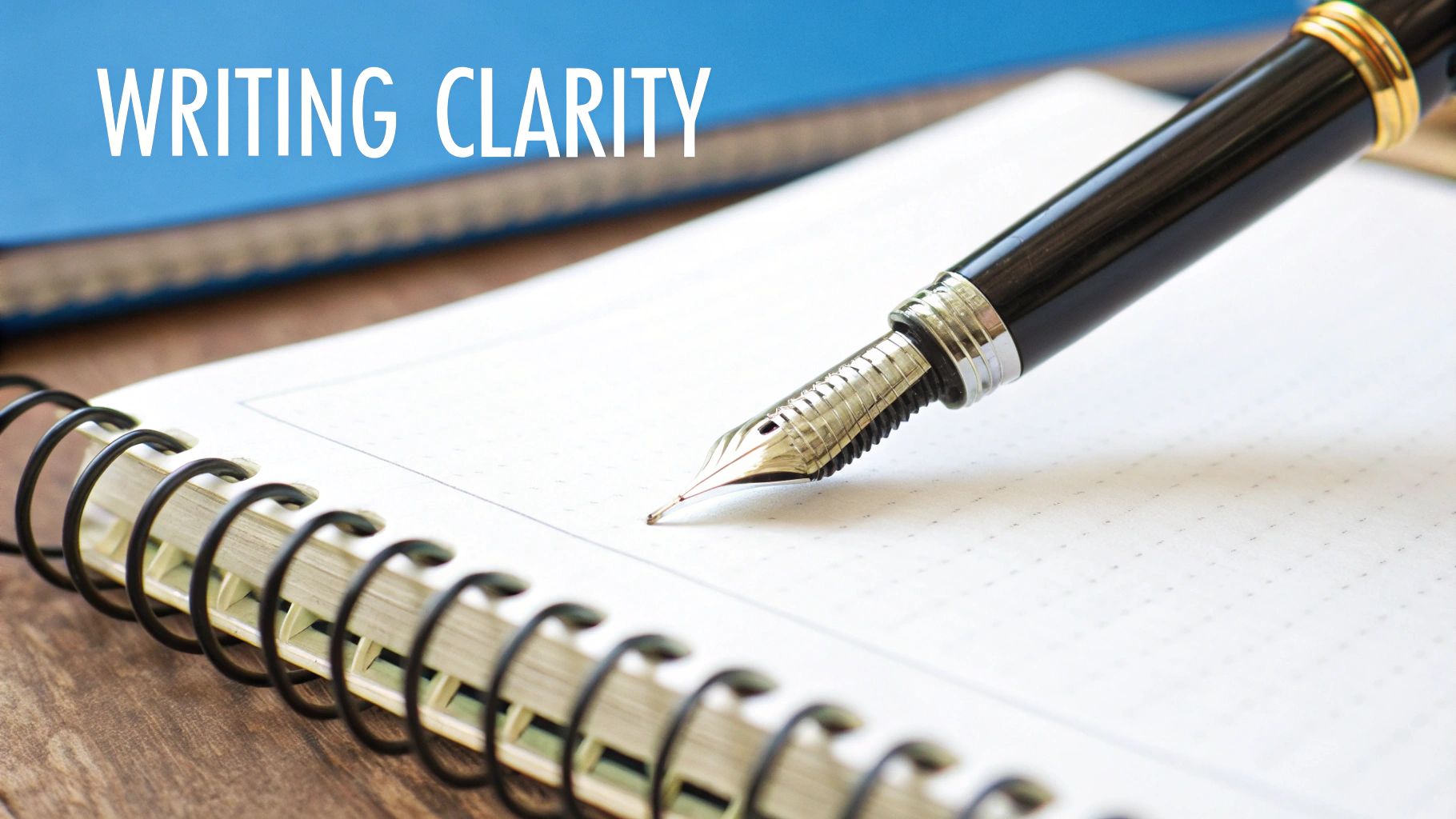Navigating the Academic Writing Landscape

Clear and effective writing is essential for success in academia. From short research papers to lengthy dissertations, academic writing takes many forms – each with its own goals and requirements. Understanding these different formats helps scholars communicate their ideas clearly and make meaningful contributions to their fields. Let's explore the key types of academic writing and how successful writers adapt their approach for each one.
Decoding the Purpose of Different Academic Writing Formats
Academic writing serves many purposes within scholarly communities. For example, research papers present new empirical findings, while literature reviews analyze and synthesize existing research on a topic. Each format has specific conventions that help writers achieve their goals – whether that's reporting original data or identifying gaps in current knowledge. Understanding these distinct purposes is crucial for crafting effective academic work.
Research Papers: Unveiling New Insights
Research papers are foundational to advancing knowledge in academic fields. Writers follow a clear structure, typically including sections for the abstract, introduction, methods, results, discussion, and conclusion. The writing emphasizes precision and objectivity. For example, a paper on teaching methods would carefully explain the research approach, present data clearly, and analyze results thoroughly. Most importantly, it would show how the findings build on previous work and advance understanding in education.
Literature Reviews: Synthesizing Existing Knowledge
A literature review takes a different approach than a research paper. Rather than presenting new data, it examines existing studies on a topic to identify key themes, debates, and areas needing further research. For example, a literature review might analyze dozens of studies on online learning to understand what works best and what questions remain unanswered. This synthesis helps scholars see the big picture and spot promising directions for new research.
Dissertations: The Pinnacle of Academic Achievement
The dissertation represents years of focused research and scholarly growth. These substantial works combine original research with extensive analysis of existing literature. Writers must construct clear arguments supported by extensive evidence while demonstrating mastery of their field. For instance, an education dissertation exploring technology's impact on learning would gather diverse data, analyze it rigorously, and explain the implications for teaching practice. The work must make a meaningful contribution to knowledge in the field.
By learning the specific requirements of each format, scholars can communicate their ideas more effectively to academic audiences. Careful attention to purpose and audience strengthens their ability to participate in scholarly conversations and advance knowledge in their disciplines.
Transforming Data into Compelling Stories
Academic writing is much more than following proper formats and structures. The real impact comes from skillfully weaving data and evidence into a compelling narrative that strengthens your arguments. Many writers feel intimidated by statistics and numbers, but with the right approach, you can make data work naturally within your writing.
From Numbers to Narrative: The Art of Data Integration
Using data effectively in academic writing requires thoughtful integration that advances your key points. Think of data as building blocks that provide essential support for your arguments. Rather than overwhelming readers with raw numbers, focus on strategically presenting data that directly connects to your main ideas. For instance, instead of just stating "75% of participants preferred Method A," explain the significance of this finding and how it helps answer your research question. The goal is meaningful interpretation and analysis, not just listing statistics.
Visualizing Success: Graphs, Charts, and Tables
Visual elements can powerfully enhance your data storytelling. A well-designed graph instantly reveals trends that might take paragraphs to explain in text. Similarly, a clear table lets readers quickly grasp key findings. Visual aids also break up dense text blocks, making your writing more engaging and easier to follow. However, visuals need proper context – always clearly label graphs, charts, and tables while explaining their relevance to your broader argument in the surrounding text.
Balancing Precision and Readability
While academic writing demands accuracy, readability matters just as much. You need to represent data precisely without letting technical language obscure your message. Consider trying to explain a complex scientific concept using only field-specific terminology – most readers would struggle to follow along. The key is finding the right balance between technical precision and clear, accessible language that effectively communicates your findings. You might be interested in: How to master academic writing with SmartStudi's AI tools.
Real-World Examples: Learning from the Best
One of the best ways to improve your data integration skills is studying how published authors do it successfully. Look for papers where writers smoothly incorporate data into their narrative flow while keeping complex information clear and engaging. Pay attention to how they use visuals, explain results, and connect data back to main arguments. Notice transition phrases like "As Figure 1 illustrates…" or "The data in Table 2 reveals…" that help blend technical information into the text. By learning from strong examples, you can develop your ability to transform raw data into meaningful insights that strengthen your academic writing.
Building Arguments That Stand Their Ground

Writing persuasively is essential for academic success. It requires more than just presenting facts – you need to construct logical, well-supported arguments that convince readers of your position. Let's explore how skilled academic writers build strong cases for their ideas, with concrete examples and proven techniques for developing clear thesis statements, incorporating evidence, and addressing counterpoints.
Developing a Rock-Solid Thesis
Your thesis statement sets the foundation for your entire argument. To be effective, it must clearly state your main claim and preview your key points. For instance, rather than writing vaguely that "Social media affects society," you might argue that "Social media has reshaped political discourse by making it easier for false information to spread and increasing divisions between different groups." This specific thesis gives readers a clear sense of your argument's direction and scope. The best thesis statements are also debatable – they make claims that could reasonably be challenged, setting up space for meaningful discussion.
Integrating Evidence Effectively
Strong arguments need solid evidence to back them up. Think of your argument like constructing a building – your thesis provides the foundation, while carefully chosen evidence forms the supporting structure. When incorporating sources, don't just drop in quotes and move on. Take time to analyze how specific evidence supports your points. For example, after sharing statistics about online harassment, explain what those numbers reveal about cyberbullying's prevalence and impact. This kind of thoughtful analysis shows readers how the evidence connects to your broader argument.
Addressing Counterarguments Head-On
A strong academic argument acknowledges opposing views. By directly engaging with potential counterpoints, you demonstrate that you've thoroughly considered different perspectives. This builds credibility with readers and strengthens your position. When addressing counterarguments, present them accurately and fairly before explaining why your view is more convincing. You might point out flaws in the opposing logic, present contradicting evidence, or offer a different interpretation of key facts.
Structuring Your Argument for Maximum Impact
How you organize your ideas shapes how readers follow your reasoning. Academic arguments typically use structures like:
- Problem-Solution: Describing an issue and proposing ways to address it
- Cause-Effect: Examining how one factor leads to specific outcomes
- Compare-Contrast: Analyzing similarities and differences between concepts
Choose a structure that fits your topic and purpose. Clear topic sentences and smooth transitions help readers track your logic from point to point. Well-organized arguments are more persuasive because they're easier to understand and evaluate.
Mastering Academic Style and Format
Strong research and compelling arguments can fall flat without proper academic presentation. The specific style and formatting conventions of scholarly writing play a key role in how effectively your ideas come across to readers. While they may seem like minor details at first, these standards significantly impact your work's credibility. Having clear examples of academic writing to reference can help immensely as you develop your scholarly voice.
The Importance of Consistency and Accuracy
When formatting is inconsistent, it pulls focus from your core ideas and weakens your paper's authority. Small details matter – like choosing whether to write numbers as words or numerals, or keeping date formats uniform throughout. For instance, APA style specifies that numbers one through nine should be written as words, while 10 and up use numerals. This kind of precision helps create a polished final product. Using standardized citation formats (MLA, Chicago, or APA) also ensures proper attribution of sources. For more guidance, see our resource on how to master citations.
Navigating Style Guides: A Practical Approach
Style guides like the MLA Handbook and APA Manual provide detailed direction on everything from citations to visual elements. Though they can feel overwhelming initially, these guides offer clear paths to proper academic presentation. Going beyond memorizing rules, understanding the core principles of clarity, consistency and ethical source attribution will serve you well. Take block quotes as an example – knowing how to format them correctly allows you to smoothly incorporate longer passages while maintaining academic integrity.
Tone and Language: Finding Your Scholarly Voice
Academic writing requires a distinct professional tone that avoids casual language while aiming for objectivity and precision. Compare "The results were pretty good" to "The results indicated a statistically significant improvement." The second version provides concrete, measurable information appropriate for scholarly work. Finding the right balance between accessibility and academic rigor takes practice but is essential for engaging an academic audience effectively.
Learning from Examples: The Power of Observation
One of the best ways to improve your academic writing is to study published works in your field. Pay attention to how experienced authors handle complex formatting, integrate statistics, use headings, and structure their papers. Notice the specific techniques that make their writing clear and professional. Looking at both strong and weak examples side-by-side can help identify exactly what elements create a polished academic paper. This kind of careful observation will strengthen your own writing over time.
Crafting Literature Reviews That Matter

A literature review serves as the bedrock for advancing scholarly knowledge. It goes beyond simply summarizing prior research – it demonstrates your mastery of the field and your ability to weave complex findings into a compelling story. This section explores how successful authors transform extensive research into clear academic writing that propels their work forward.
Organizing the Research Landscape
Rather than just listing sources, effective literature reviews strategically map out connections and patterns in the research. Think of it like building a mosaic – each individual study is a piece that contributes to the complete picture of understanding on your topic. Many authors organize their reviews thematically, grouping studies that examine related concepts or questions. For example, a review on online learning might include sections on student engagement, technology infrastructure, and teaching methods. This thoughtful organization helps readers grasp the key areas of study within the field.
Identifying Meaningful Patterns and Contrasting Viewpoints
The best literature reviews move past basic summaries to provide insightful analysis. This means spotting recurring themes, examining differing perspectives, and uncovering gaps in current research. For instance, a review might show that researchers agree on the value of student-teacher interaction in online courses, but disagree on the most effective ways to create those connections. This kind of analysis shows deep engagement with the literature while setting up the author's unique research contribution. Pointing out areas where research is limited also helps justify why new studies are needed.
Maintaining Objectivity While Demonstrating Engagement
Academic writing requires a balanced perspective, even when reviewing research that sparks strong reactions. Yet being objective doesn't mean being detached. Strong authors show their expertise by carefully evaluating the merits and limitations of existing studies. They examine research methods, consider potential biases, and assess whether findings apply broadly. For example, when reviewing studies on a teaching technique, an author might acknowledge positive outcomes while noting limitations like small sample sizes or missing control groups. This measured approach builds credibility and strengthens the overall analysis.
Practical Strategies for Presenting Academic Writing Examples
Using specific examples from the literature is key for a convincing review. These examples should be focused illustrations rather than lengthy summaries. Authors often include brief quotes or paraphrases to highlight important findings. Creating tables or charts to compare key aspects of different studies, such as methods and results, can also make complex information easier to grasp. This strategic use of examples, combined with clear academic writing, transforms the literature review from a passive overview into an active scholarly contribution. It shows the author's command of existing research while establishing them as an informed voice in ongoing academic discussions.
Overcoming Common Writing Challenges

Writing strong academic papers often feels daunting, especially when facing that initial blank page. Many students struggle with common challenges, from research to revision. This section will help you tackle these obstacles head-on with practical strategies you can use right away.
Conquering Analysis Paralysis
Getting stuck in endless research is a common issue that can stop your writing progress cold. When faced with mountains of information, it's easy to feel overwhelmed and unsure where to start. The solution? Set clear boundaries for your research from the beginning. Choose specific keywords related to your topic and stick to relevant academic sources. Breaking your research into scheduled blocks with deadlines helps prevent endless browsing and keeps you moving forward with purpose.
Maintaining Momentum and Avoiding Writer's Block
Even experienced writers sometimes hit a wall where words just won't flow. When you're feeling stuck, try freewriting – set a timer for 10 minutes and write continuously without stopping to edit or judge your work. This helps bypass your internal critic and often reveals unexpected insights. For example, if you're writing about education policy, you might freewrite about your own school experiences to spark fresh perspectives. Sometimes a simple change of environment, like moving to a different room or heading to a coffee shop, can help restart your creative flow.
Handling Feedback Constructively
Getting feedback on your writing is essential but can be tough emotionally. Instead of seeing comments as criticism, view them as tools for improving your work. Start by reading each suggestion carefully and considering how it could strengthen your paper. For instance, if someone notes that your argument needs more evidence, look for specific examples or data to support your points. When feedback seems unclear, don't hesitate to ask questions – most instructors welcome the chance to clarify their suggestions. Check out our guide on how to master grammar and style in your academic writing for additional tips.
The Power of Strategic Revision
Good revision goes far beyond fixing spelling errors. Start by reviewing your thesis statement – does it still match your argument after completing your research? Make it stronger and clearer if needed. Next, focus on making your writing more precise by replacing vague words with specific terms and removing unnecessary phrases. Check that your ideas flow naturally from one point to the next, with each paragraph building on previous points. Sometimes you'll need to move entire sections to improve your paper's overall structure. This careful revision process turns basic writing into compelling academic work that makes meaningful contributions to scholarly discussions.
Ready to improve your academic writing? Explore SmartStudi's suite of writing tools, designed to help you research effectively, write clearly, and succeed academically. Visit SmartStudi today!
